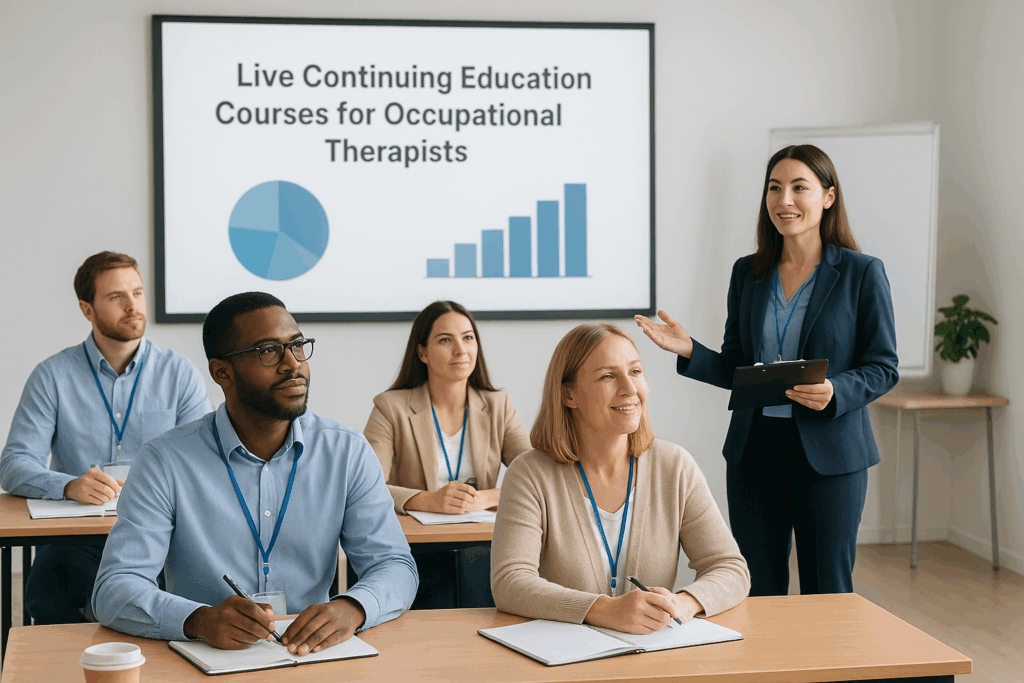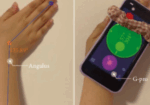Beste Live-Weiterbildungskurse für Ergotherapeuten
abgelegt unter Nicht kategorisiert
Einführung in die Live-Weiterbildung für Ergotherapeuten
Die Ergotherapie ist ein sich ständig weiterentwickelndes Feld, und Fachkräfte müssen stets auf dem neuesten Stand sein, um die bestmögliche Patientenversorgung zu gewährleisten. Eine der effektivsten Möglichkeiten, sich als Praktiker weiterzuentwickeln, ist die Teilnahme an Live-Weiterbildungen für Ergotherapeuten. Diese Kurse erfüllen nicht nur die staatlichen Zulassungsanforderungen, sondern bieten auch die Möglichkeit, klinische Fähigkeiten zu verbessern, das Wissen zu erweitern und Kontakte zu Berufskollegen zu knüpfen.
Im Gegensatz zu voraufgezeichneten oder selbstgesteuerten Programmen, Live-CEU-Kurse stellen interaktive Lernerlebnisse in den Vordergrund. Durch Echtzeitdiskussionen, praxisorientierte Workshops und direkten Zugang zu Dozenten gewinnen Ergotherapeuten praktische Erkenntnisse, die sie sofort in der Praxis anwenden können.

Warum Weiterbildung für Ergotherapeuten unerlässlich ist
Aufrechterhaltung der Berufszulassung
Jeder Staat in den USA verlangt von Ergotherapeuten, eine bestimmte Anzahl von Weiterbildungseinheiten (CEUs) um ihre Lizenz zu behalten. Live-Kurse werden oft von staatlichen Gremien und Berufsverbänden wie der Amerikanische Vereinigung für Ergotherapie (AOTA), was sie zu einer zuverlässigen Wahl für die Erfüllung dieser Anforderungen macht.
Erweiterung klinischer Fähigkeiten
Das Gesundheitswesen ist dynamisch und OTs müssen mithalten neue therapeutische Techniken, neue Technologien und sich entwickelnde PatientenbedürfnisseVon der neurologischen Rehabilitation bis zur pädiatrischen Versorgung bieten Live-CEU-Sitzungen aktuelle Schulungen direkt von führenden Experten auf diesem Gebiet.
Verbesserung der Patientenergebnisse
Letztendlich kommt die Weiterbildung den Patienten zugute. Durch das Erlernen der neuesten evidenzbasierten Strategien können Ergotherapeuten verbesserte Interventionen anbieten, die die Unabhängigkeit fördern, Risiken reduzieren und die allgemeine Lebensqualität verbessern.
Live-CEUs im eigenen Tempo oder online: Was ist besser?
Vorteile von Live-Weiterbildungskursen
- Echtzeit-Interaktion mit Dozenten
- Möglichkeiten, Fragen zu stellen und sofortiges Feedback zu erhalten
- Praktische Fertigkeitsübungen durch Workshops
- Vernetzung mit Kollegen aus anderen Fachbereichen
Nachteile von Kursen im eigenen Tempo
Obwohl bequem, fehlen bei Kursen im eigenen Tempo interaktive Komponenten und praktische Anwendungen. Lernende können sich isoliert fühlen und ohne strukturierte Fristen kommt es leicht zum Aufschieben.
Live-Kurse hingegen fördern Verantwortlichkeit und tieferes Engagement.
Beliebte Themen in Live-CEU-Kursen für OTs
CRPS-Behandlung
Die Kurse behandeln die Behandlung des komplexen regionalen Schmerzsyndroms und Techniken zur Linderung der Symptome.
Pädiatrische Ergotherapie
Zu den Schwerpunktbereichen gehören sensorische Integration, Entwicklungsmeilensteine und schulbasierte Interventionen.
Altenpflege und Sturzprävention
Angesichts der alternden Bevölkerung besteht eine große Nachfrage nach Ergotherapeuten, die bei Mobilität, Gleichgewichtstraining und adaptive Gerätenutzung.
Psychische Gesundheit in der Ergotherapiepraxis
Weitere Kurse konzentrieren sich auf die Rolle der Ergotherapie in Stressmanagement, Bewältigungsstrategien und Neugestaltung des Lebensstils für das geistige Wohlbefinden.
Top-akkreditierte Anbieter, die Live-CEU-Kurse anbieten
Amerikanische Vereinigung für Ergotherapie (AOTA)
AOTA veranstaltet jährlich Konferenzen, Live-Webinare und landesweit anerkannte Fachworkshops.
Handtherapie-Akademie
Bekannt für seine interaktive Live-Webinare und große Bibliothek von OT-spezifischen CEU-Kurse.
Landesspezifische OT-Verbände
Viele Staaten veranstalten regionale Konferenzen und Workshops, die auf lokale Lizenzanforderungen.
So wählen Sie den richtigen Live-CEU-Kurs aus
- Akkreditierung und CEU-Zulassung – Überprüfen Sie immer, ob der Kurs AOTA-geprüft oder von Ihrem Landesvorstand anerkannt.
- Fachwissen und Ruf des Ausbilders – Wählen Sie Kurse, die von erfahrenen Klinikern mit nachgewiesener Fachkompetenz unterrichtet werden.
- Relevanz für Ihren Tätigkeitsbereich – Konzentrieren Sie sich auf Kurse, die auf Ihr Arbeitsumfeld abgestimmt sind – sei es Pädiatrie, Geriatrie oder Akutversorgung.
Die Kosten für Live-Weiterbildungskurse
Durchschnittliche Preise für CEUs
Live-CEU-Kurse reichen normalerweise von $50–$300 pro Sitzung, je nach Anbieter und Länge.
Mitgliedschaftsrabatte und -pakete
Plattformen wie handtherapyacademy.com bieten unbegrenzte CEUs für eine pauschale Jahresgebühr.
Vom Arbeitgeber gesponserte Weiterbildungsmöglichkeiten
Viele Krankenhäuser, Kliniken und Schulen bieten Erstattung oder Stipendien für Weiterbildung. Fragen Sie immer Ihre Personalabteilung.
Tipps zur optimalen Nutzung von Live-CEU-Kursen
- Vernetzung mit Gleichgesinnten – Bauen Sie Verbindungen auf, die zu Zusammenarbeit und Karrieremöglichkeiten führen können.
- Wissen sofort anwenden – Setzen Sie neue Strategien so schnell wie möglich bei Patienten um.
- Verfolgung von CE-Credits für die Lizenzierung – Verwenden Sie Apps oder Tabellen, um abgeschlossene Kurse und Zertifikate zu protokollieren.
Häufig gestellte Fragen (FAQs)
1. Was gilt als Live-Weiterbildung für Ergotherapeuten?
Live-Webinare, Workshops und Konferenzen, bei denen die Teilnehmer in Echtzeit interagieren.
2. Wie viele CEUs benötigen OTs pro Jahr?
Die Anforderungen variieren je nach Staat, aber die meisten erfordern 12–24 Stunden alle 1–2 Jahre.
3. Sind Live-CEU-Kurse wertvoller als aufgezeichnete?
Ja, denn sie bieten interaktives Lernen, Feedback und praktische Übungen.
4. Können Live-CEUs online absolviert werden?
Auf jeden Fall! Viele Anbieter bieten Live-Streaming-Webinare für CE-Credits zugelassen.
5. Zahlen Arbeitgeber für OT CEU-Kurse?
Viele Gesundheitsorganisationen Kosten decken oder OTs die erforderlichen CEUs erstatten.
Fazit: Steigern Sie Ihre OT-Karriere mit Live-CEUs
Investieren in Live-Weiterbildungen für Ergotherapeuten ist mehr als eine Zulassungsvoraussetzung – es ist ein professionelles Engagement für Spitzenleistungen. Durch Echtzeit-Lernen können Ergotherapeuten ihre klinischen Fähigkeiten verbessern, Branchentrends voraus sein und die Patientenergebnisse verbessern. Ob auf AOTA-Konferenzen, Webinaren der Hand Therapy Academy oder Workshops der Landesverbände – die Möglichkeiten sind endlos.
Mehr zum Lesen
Kennen Sie die geheime Zutat für die Genesung nach einer Verletzung?
Kennen Sie die geheime Zutat für die Genesung nach einer Verletzung? Ich gebe Ihnen einen Hinweis: Es besteht aus 5 Buchstaben und beginnt mit dem Buchstaben S. SCHLAF Haben Sie sich jemals eine Frage gestellt: Hilft Schlaf bei der Heilung von Verletzungen? Dies ist für Sie, damit Sie es mit Ihren Patienten teilen können, es dient aber auch als…
Mehr lesenAuswirkungen verschiedener Dehntechniken zur Verbesserung der Gelenkbeweglichkeit.
Referenz: Oba, K., Samukawa, M., Abe, Y., Suzuki, Y., Komatsuzaki, M., Kasahara, S., Ishida, T. & Tohyama, H. (2021). Auswirkungen intermittierender und kontinuierlicher statischer Dehnung auf den Bewegungsumfang und die viskoelastischen Eigenschaften des Muskel-Sehnen-Systems basierend auf einem dauerangepassten Protokoll. International Journal of Environmental Research and Public Health, 18(20), 10632. https://doi-org.libproxy.nau.edu/10.3390/ijerph182010632 The Skinny: Diese Studie verwendete ein Crossover…
Mehr lesenDie Identifizierung mobiler Anwendungen für die Rehabilitation nach distalen Radiusfrakturen.
Von Taylor Landholm Chen, Y., Yu, Y., Lin, X., Han, Z., Feng, Z., Hua, X., Chen, D., Xu, X., Zhang, Y. und Wang , G. (2020). Intelligente Rehabilitationsunterstützungstools für distale Radiusfrakturen: Eine systematische Überprüfung basierend auf Literatur und mobilen Anwendungsspeichern. Computergestützte und mathematische Methoden in der Medizin, 2020, 7613569. https://doi-org.methodistlibrary.idm.oclc.org/10.1155/2020/7613569 The Skinny The…
Mehr lesenSchienenoptionen für steife Fingergelenke
Nach einer Verletzung des proximalen Interphalangealgelenks kommt es häufig zu einem Verlust der Bewegungsfreiheit, typischerweise sowohl in der Flexions- als auch in der Extensionsebene. Deshalb haben wir eine Liste mit hilfreichen Schienungsmöglichkeiten für steife Fingergelenke zusammengestellt. Zur Verbesserung der Beugung des PIP-Gelenks. Beugungswickel mit elastischem Band (Coban): Dies ist eine sehr einfache…
Mehr lesenMelden Sie sich an, um Updates direkt in Ihren Posteingang zu erhalten!
Melden Sie sich bei uns an und wir senden Ihnen regelmäßig Blogbeiträge zum Thema Handtherapie, Benachrichtigungen jedes Mal, wenn wir neue Videos und Tutorials hochladen, zusammen mit Handzetteln, Protokollen und anderen nützlichen Informationen.






